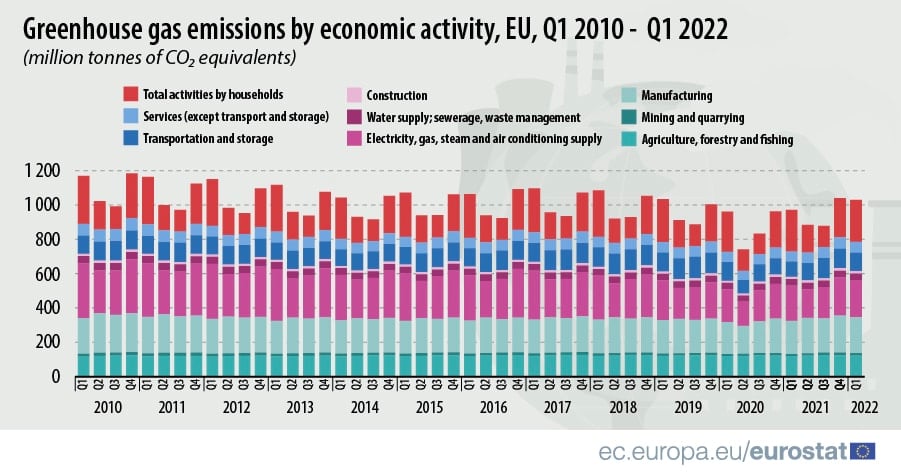(CN) — First quarter greenhouse gas emissions in the European Union have lurched upward since 2020, according to data released Tuesday by Eurostat, but they remain below pre-Covid levels.
Eurostat, the EU's statistical office, measures greenhouse gas emissions from economic activities including transportation, manufacturing, industries and households. The emissions include carbon dioxide, nitrous oxide and methane, among other gases.
“Each greenhouse gas has a different capacity to cause global warming, depending on its radiative properties, molecular weight and the length of time it remains in the atmosphere,” the office explained. Each gas is assigned a metric referred to as its global warming potential (GWP), which can be used to convert emissions of greenhouse gases to a measure known as carbon dioxide, or CO2, equivalents..
Emissions have generally trended downward since the fourth quarter of 2010, when they were measured at a high of 1,187 million tons of CO2 equivalents. Long-term data also indicates emissions are seasonal, typically spiking in the first and fourth quarters and falling in the second and third. The data shows that in the second quarter of 2020, while the Covid-19 pandemic brought much of the continent to a standstill, emissions plunged to a low of 742 million tons of CO2 equivalents.
Afterward, emissions increased to 843 million tons by the third quarter of 2020 and 973 million by the first quarter of 2021. The first quarter of 2022 generated 1,029 million tons of emissions, which remains just below the 1,035 million tons measured in the first quarter of 2019, the last year before the pandemic took hold.
“This increase is largely due to the effect of the economic rebound after the sharp decrease in activity caused by the Covid-19 crisis,” Eurostat reported.
The sectors responsible for the most emissions include households with 24% of measurable emissions, utilities with 21%, manufacturing with 20%, agriculture with 12% and transportation and storage with 10%. Consumer emissions are accounted for under the household category, along with personal vehicles. Commercial transportation, including airlines, freight and taxis, are accounted for in the transportation and storage sector. The sectors with highest increases in emissions were transportation and storage, mining and construction.
Geographically, increased emissions have been measured in every member nation except for Slovakia, Finland and the Netherlands. Slovakia’s emissions remained flat, while emissions have decreased 1% in Finland and 9% in the Netherlands over the past year. On the other hand, nations experiencing the largest increases in emissions include Bulgaria with 38%, Malta with 21% and Ireland with 20%.
“Air emissions accounts measure the interplay between the economy and the environment with respect to air emissions, in order to assess whether current production and consumption activities are on a sustainable path of development,” Eurostat explained. “The data obtained from air emissions accounts may subsequently feed into political decision-making, underpinning policies that target both continued economic growth and sustainable development.”
In 2020, the European Commission, the EU's executive body, adopted policies known as the European Green Deal aimed at reducing greenhouse gas emissions by 50% by 2030 and becoming a net-zero emitter by 2050. The EU is also a party to the broader Paris climate agreement signed in 2015.
According to the Global Carbon Project, the EU made more progress than any other political subdivision on the reduction of greenhouse gas emissions from 2000 to 2020, with an average annual reduction of 2.8%. But reductions in the EU — and to a smaller degree in the United States — have been offset by increased emissions in China and other developing countries, GCP reported.
Subscribe to Closing Arguments
Sign up for new weekly newsletter Closing Arguments to get the latest about ongoing trials, major litigation and hot cases and rulings in courthouses around the U.S. and the world.









